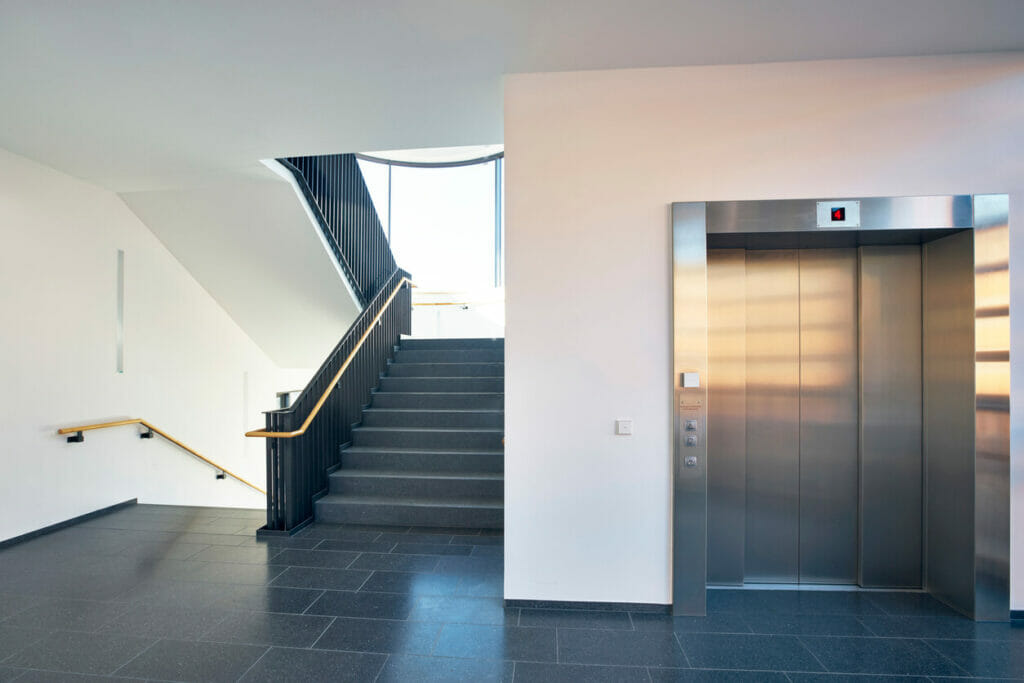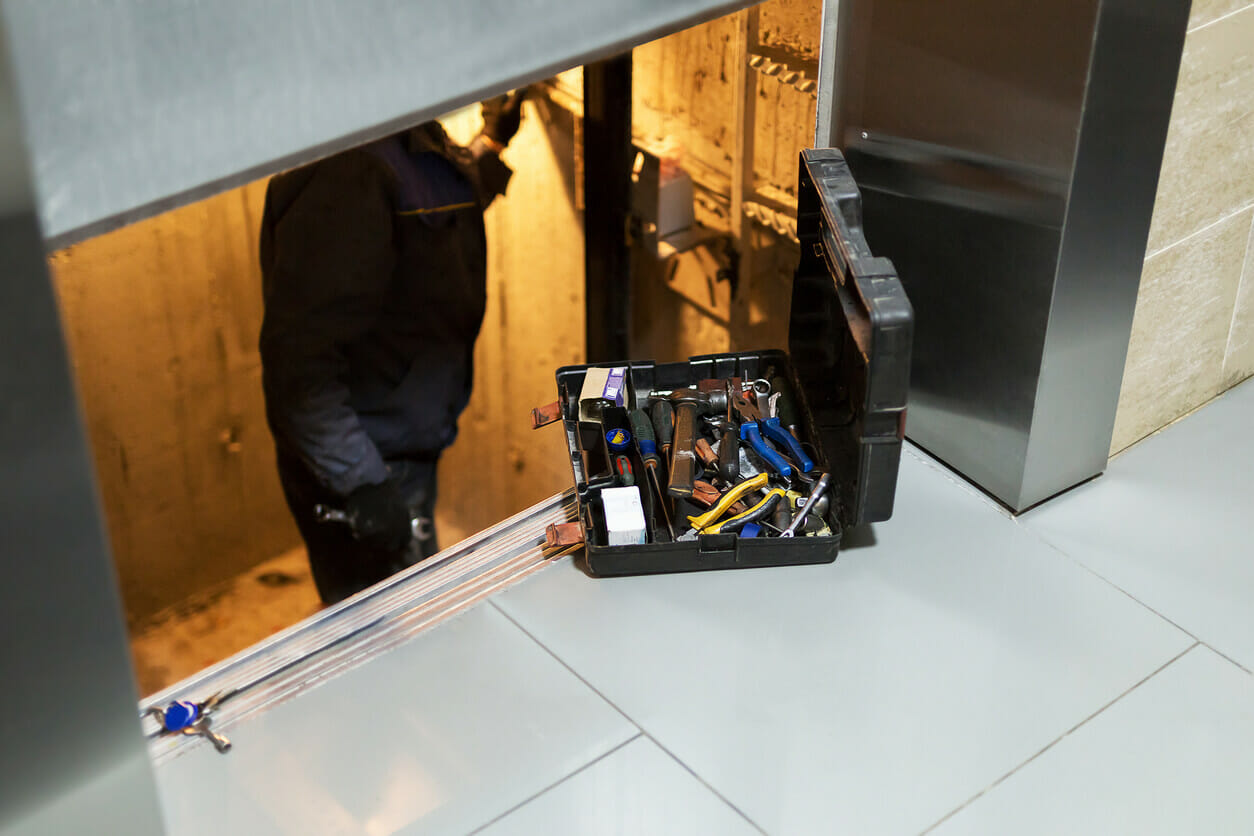There are approximately 20,000 elevators operating in buildings across Ontario, and about 1,550 of them are more than 50 years old. Another 10,000 are over 25 years old.
Perhaps then it’s no surprise that firefighters in the province respond to nearly 5,000 calls from people trapped in elevators every year.
Table of contents
- Information about the industry
- Types of elevators
- Elevator lifespan
- The importance of preventative maintenance
- How often do elevators need maintenance
- Laws to ease elevator woes
- Replacing elevators
- Minimizing disruption
The problem is complex, and can be equally painful for anyone living in a condo or apartment building. Being trapped in an elevator can be scary, and there’s no guarantee you’ll be freed right away.
Preventative elevator maintenance is critical to ensuring elevators don’t break down suddenly. Not only does the maintenance work reduce angry complaints from residents, but helps ensure elevators reach the full potential of their lifespan. Yes, maintaining elevators can be expensive, but replacing them costs hundreds of thousands of dollars.
A bit of information about the industry
The Canadian elevator industry is controlled by four big companies. Unfortunately, this has created a big labour supply shortage, which results in longer wait times.
The costs for installing and maintaining elevators are also very high because the elevator industry is one of the most regulated niche industries. Again, only a handful of people can legally carry out elevator repairs.
It quickly becomes obvious why it is so crucial for a condo building to schedule elevator maintenance work before care is needed.
Condo Control’s maintenance tracking solution gives management the ability to schedule recurring maintenance jobs ahead of time, as well as maintain detailed information about each elevator component.
You can also attach important documents, like maintenance orders, contracts or receipts, to systems or individual components, making it easy to go back and check what was done to any piece of equipment.
Types of elevators
Elevators are designed and fitted into a building according to its population, and the intended usage of the elevator. So, more modern condos might have three service elevators, and one larger elevator that is equipped for move-ins and move-outs.
Elevators are classified based on function and build. There are traction elevators, hydraulic elevators, machine-room-less elevators and vacuum elevators.
In most cases, condo buildings have either traction or hydraulic elevators.
Traction elevators
Traction elevators are lifted using ropes that pass over a wheel connected to an electric motor. When the motor starts, the wheel moves. The rope is pulled and the elevator car is lifted or lowered to transport residents.
A counterweight is also added to make the elevators more efficient by offsetting the weight of the car and occupants.
There are two categories of traction elevators – geared and gearless elevators.
Geared traction elevators have a gearbox attached to the motor. This drives the wheel. These elevators achieve a travel speed of up to 500 feet per minute, but they can’t reach very high heights.
The wheel is directly attached to the motor in gearless traction elevators. They offer a speed of up to 2000 feet per minute and have a max travel distance of around 2000 feet. They are the top choice for high-rise buildings.
Hydraulic elevators
Hydraulic elevators employ a piston at the bottom of the elevator to push it to different floors. An electric motor forces oil, or any hydraulic fluid, to move the piston. This type of lift has a slower mechanism compared to traction elevators. Hydraulic elevators are typically used for low-rise buildings of eight or fewer floors.
Elevator lifespan
Most elevator components have a useful life of 20 to 25 years. After 20 years in operation, the elevator may no longer be cost effective to maintain.
Some components become obsolete and can no longer be purchased. In these cases, the building may need to modernize the elevator.
Preventative maintenance is imperative
Preventative maintenance helps keep elevators in good working order and extends the equipment’s useful lifespan. Maintenance involves more than routine safety inspections; buildings must act on feedback they receive from mechanics after inspections are completed. If possible, obtain quotes with reports so that the building can budget for repairs.
Maintenance logs should also be inspected on a regular basis. Don’t be afraid to ask questions or meet with the mechanic to get a better understanding of the elevators and their current condition.
Maintenance evaluations
Sometimes, if your elevators are having a lot of issues, it is helpful to ask for another professional opinion.
An elevator with one malfunction every two months is generally considered reliable. If there are weekly issues, this is a sign that current maintenance work is either insufficient or not occurring often enough.
A maintenance evaluation is different from a safety inspection. The former ensures elevators are being properly serviced. If you suspect your elevator needs better care, start by scheduling a maintenance evaluation.
How often do elevators require care?
Maintenance work really varies depending on the size of the community, but experts would recommend a monthly visit from your elevator maintenance technician. This may not be possible or necessary, but elevator maintenance work should occur at least four times per year.

Your elevator maintenance contract should detail how often the technician will inspect the elevators. Contracts may also include:
- Provisions for compensation when monthly visits are missed
- Specific maintenance tasks that will be completed, and roughly how long they will take to complete
- Clear maintenance standards. Original manufacturer’s standards are typical and may include running speed, noise levels, acceleration and door movement times
- An elevator malfunction benchmark target. When malfunctions are more frequent than targets, this is an indication that service or maintenance may be a problem
Laws to ease elevator woes
Elevator care has been a challenging issue for some condo buildings. The expenses, lack of available technicians, and longer wait times for equipment due to supply chain issues have created extended disruptions in some condo communities. Residents who have mobility issues or live with disabilities aren’t just inconvenienced; their independence may be drastically reduced.
A few laws have been passed in Ontario which aim to address repair delays. While they may help, they aren’t a complete solution.
Reporting outages
In July of 2022, legislation that requires extended elevator outages in residential buildings to be reported to the Technical Standards and Safety Authority (TSSA) came into effect. The new rules, which seek to enhance the availability, safety and maintenance of elevators in Ontario, will also give the public access to information about elevator outages via the TSSA website.
The reporting needs to be completed within 30 days after the day the elevator was returned to service. Only elevator owners or licensees can report elevator outages using the TSSA portal.
Fines for non-compliance
Way back in 2017, Bill 109, Reliable Elevators Act, was brought forth. It amended the Building Code Act, 1992, and the Consumer Protection Act, 2002, in respect of elevators and elevating device mechanics.
If it was approved, a person who applies for a permit to construct a building with seven or more stories would need to show that building will have enough elevator capacity, elevator maintenance contracts would be subject to the protections under the Consumer Protection Act, 2002, and an elevator that broke down would need to be repaired within 14 days for most buildings, and seven days for long-term care homes and retirement homes, unless the regulations provide otherwise.
While the bill passed, it was never proclaimed into law. Last year, regulatory changes were approved that allow the TSSA to impose financial penalties on elevator companies for non-compliance with legal requirements.
At some point, elevators will need to be replaced
Even well-maintained elevators need to be replaced eventually. When the time draws near, buildings will need to be proactive and inform residents as soon as possible. If there is only one elevator in the building, management should expect to make accommodations for residents who have mobility issues.
It can take 8 to 10 weeks to replace one elevator, but that time could be longer depending on the circumstances. It can cost anywhere from $175,000 to $300,000 to replace a single cab.
When preparing a request for proposal it is in the best interest of the condominium to ask for non-proprietary materials and elevator controller. This will allow any elevator contractor to maintain the equipment in the future.
Minimizing disruption
When planning for an elevator repair or replacement, managers should take this time to make additional changes that may be required, including taking steps to ensure the elevators are up to current code requirements. Having multiple repairs scheduled at one time is the best way to utilize a mechanic’s time.
Review accessibility concerns of occupants in the building prior to starting a project. Installing a stair lift for the duration of a project would be beneficial if there is only one elevator or if there are several people who cannot easily go up and down stairs.
Finally, alert residents about the upcoming repair as soon as possible. Post physical notices on every level the elevator services, and send out digital messages through the software or portal used by the building.
The notices should advise residents of roughly how long the repair will take, and suggest alternative options for people with mobility issues or people who will need to transport large items to/from their units.


